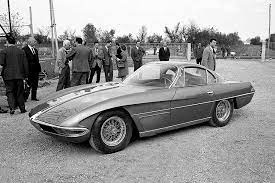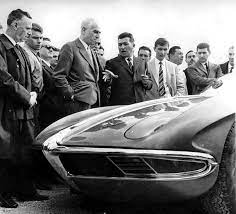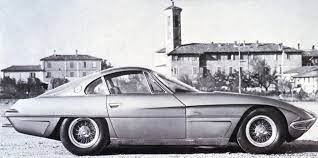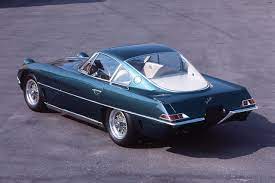by Peter Robinson
October 29, 1963. Ferruccio Lamborghini has invited a handful of journalists to his unfinished factory in Sant’Agata Bolognese. For months rumours the Italian tractor manufacturer planned to challenge Ferrari’s road cars circulated in the bars of Modena. The cluster of people gathered outside the factory near the quiet farming village anticipate something special.

Lamborghini wanted his car to look different from existing Ferraris and Maseratis. And different the 350 GTV was. The onlookers, far more accustomed to the refined beauty of Pininfarina’s designs, were left stunned by the highly sculptured, chrome laden form, flowing curves with razor edges and a small multi-curved glasshouse. Under the badge of the charging bull and below Ferruccio Lamborghini’s chromium signature scrawled across the sloping bonnet, they supposed sat the V12 of Italy’s new GT car. If the Lamborghini’s flamboyant styling was received only with polite compliments, plaudits were showered on the specification of the new, Giotto Bizzarrini-designed, V12 which boasted a specification far in advance of anything Ferrari offered. Remarkably, at the time, the V12 wasn’t even under the bonnet.
Lamborghini had commissioned Franco Scaglione, designer of the superb Alfa Romeo Giulietta Sprint and the wild Bertone BAT Alfas from the mid-1950s, to design the new Lamborghini, giving him only vague dimensions of the tubular spaceframe chassis and some hazy engine dimensions to work with. When Scaglione’s creation – constructed piecemeal from profile drawings by the tiny Sargiotto carrozzeria in Turin – was delivered to Sant’Agata, Lamborghini’s young and talented engineers were dismayed to find their tall dohc engine, with its six vertical twin-choke Weber carburettors, simply wouldn’t fit under the bonnet. At the reveal, what no outsider knew was that under the massive bonnet lay 500lb of ceramic tiles, there to provide the appropriate ride height.

There wasn’t time to alter the body or modify the engine, so this first Lamborghini 350 GT was rushed off to the Turin show a day later with the same tiles beneath its luscious bonnet. Astonishingly, despite coming under the gaze of a sceptical press, nobody seemed to catch on that the car not only lacked an engine – the 3.5-litre V12 sat proudly on its own display stand – but also had no pedals, no windscreen wiper, the brakes weren’t connected, there weren’t any engine mounts and the hidden headlights wouldn’t revolve. Ferruccio maintained the bonnet wouldn’t open because, in the hurry to complete the car for the show, the internal catch hadn’t been connected. In fact, there was no bonnet release mechanism.
Not even the next year, when a much modified and heavily restyled (by Touring) 350 GT was displayed at the Geneva show in March, did Lamborghini admit to his deception. In later years, he regretted showing off the prototype before the design and mechanicals were ready, but people had begun to talk about Lamborghini in the same breath as Ferrari, so the GTV had the desired effect.
That first car – Lamborghini chassis number 3500GTV 0001 – went back to Sant’Agata and sat around the factory, forgotten, as work began on the production 350 GT, the first car leaving the assembly line in May 1964.

By then the styling had evolved to reduce the many sharp edges, the disappearing headlights were replaced by a pair of oval eyes that jutted awkwardly out of the body, and the cabin was enlarged. Touring of Milan took over construction using the same Superleggera method – aluminium over a tubular frame – used by Aston Martin for the DB4. After building 120 examples of the 350 GT (according to the factory, other sources reckon the total reached 143), it became the more powerful, heavier and alloy bodied 400 GT in 1966. Only 23 350 GTs were built before a switch to steel for the two plus two variant. By then Lamborghini had the Miura on its stocks and its fame was established.
For 22 years, the GTV prototype was pushed around the factory – when there was room – and when there wasn’t it was exposed to the weather out back with other neglected Lambo mules.

Because the engine was never installed, the first Lamborghini was never driven. Bizzarrini’s original ‘racing’ engine was shoved off into a corner and ended up under a pile of unwanted automatic transmissions (for the Espada) and suspension components. Nobody had the time to modify the engine to accommodate the distributors that were driven from the rear of the engine block. On the production 350 GT, much modified and detuned by Paolo Stanzani and Giampaolo Dallara, the distributors were shifted to the front of the engine, just as the tall carburettors were changed to side-draught Webers in order to fit beneath the bonnet.
For two decades, this collection of mouthwatering machinery rotted away in Sant’Agata. There was no factory money available for a restoration, yet any inquiries from potential buyers were turned down. That is, until Bologna Lamborghini dealer Romano Bernardoni and his cousin Stefano Pasini, probably the world authority when it comes to Lamborghini history, managed to persuade the Mimran Brothers (who owned Lamborghini before the Chrysler buy-out in 1987; Ferruccio sold out in 1974) to sell some of the old cars.
Berdardoni’s EmilianAuto was one of the few dealerships that stood by Lamborghini during the dark days in the late ‘70s when it seemed the marque would disappear. He paid cash for Countachs before they were built and this helped keep the factory afloat. Bernardoni promised to restore the 350 GTV, using the original engine. It was Pasini who eventually found that first Lambo V12, easily recognised by the vertical carburettors, in a corner of the plant and so work began.
The engine bay was designed for the Bizzarrini V12’s dry sump engine – replaced by a conventional wet sump on the production cars – but Arnaldo Bazzani, the mechanic who nurtured the car through its various stages of restoration, needed to move the engine back on the chassis if it was to fit under the bonnet. This involved reducing the length of the tail shaft and some cutting of the firewall.
Finally, four years later, on 26 January 1990 – 26 years after being first paraded before journalists and just six days after the Diablo was launched – the first Lamborghini turned a wheel under its own power.
Ferruccio Lamborghini soon visited EmilianAuto to see his first born and admired the craftsmanship that went into its making. He laughed at his signature on its nose, an ego trip that was never repeated on the production cars, and reminisced about the old days.
Driving such an historic car is not to be taken lightly. Bazzani was refitting an inner door trim when I arrived early one Saturday morning. After an hour of talk, mostly driving advice, Bazzani fired up the V12. It coughed twice, spitting back through the carburettors, before slowly settling to an irregular, cammy idle. I’d been warned that first gear in the five-speed ZF gearbox was extremely high and that moving off was difficult.

Difficult! First felt as high as third in a normal gearbox as I attempted to set off. Blip the throttle quickly and the engine would almost die. Only by feeding in the power gradually to about 3500rpm and then slipping the clutch was I able to produce any forward motion. More often than not the revs would drop, inducing hesitation followed by a series of jerks, forcing me to dip the clutch to prevent the engine stalling, before repeating the whole exercise. On the flat or downhill, the problem was easy enough to cope with, but any kind of gradient demanded excessive revs, often accompanied by the sickly stench of a slipping clutch.
Could this engine, I wondered, dabbing the accelerator and feeding the clutch out ever so gently for the hundredth time, still be in the same state of tune as Bizzarrini’s original and highly-strung V12, that produced 400bhp at 8000rpm and 240lb ft of torque at an outrageous 6000rpm according to the optimistic claims at the time?
There was nothing but pops, splutters and farts as the engine struggled to reach 4000rpm and get onto the cam so that it ran properly. Above 4000rpm it felt healthy, if extremely noisy, with a deep induction roar, the engine running cleanly and strongly. In deference to the car (and its owner) I disregarded the 7000rpm redline and used 5500-6000rpm as a more prudent maximum.
With no interest in racing, Ferruccio asked Gianpaolo Dallara, who joined Lamborghini at the age of 24 in 1964, to improve the V12: meaning detune the engine for flexibility so the 350 GT was road driveable.
For the production cars, Lambo quoted 270bhp at 6500rpm, still with 240lb ft of torque but at 4500rpm. Those early cars had a reputation as reliable runners with excellent performance and a more tractable, vastly more flexible, nature than rival Ferraris as my later experience in the 400 GT and Islero proved. However, the prototype still had the original vertical carburettors (later used on the Miura), instead of the horizontal, but less efficient, Webers necessary to fit beneath the bonnet of the production 350 GTs.
Lamborghini engineers, led by 26-year-old Paolo Stanzani, insisted on five gears, double wishbone suspension front and rear and twin overhead camshafts, at a time when production Ferraris retained four forward ratios, live rear axles and single overhead camshafts for their V12s. But while the GTV clearly displayed enormous potential my drive proved there was also a desperate and obvious need for progressive development.
The worm and roller steering however was terrific and left me in no doubt that it could be carried over to the production car. Lighter, more direct and sensitive at the straight than I expected on 205/70VR15 Michelin XWXs, it still mirrored many Italian supercars in needing considerable lock at low speeds or in tight conditions. Understeer was the dominant handling characteristic, emphasised by the steering’s need for rather more lock than first impressions signalled. But the turning circle was smaller than expected and there was real feel through the slender wooden wheel rim, so the GTV never felt heavy or unwieldy.
Not so the hefty clutch or stiff brakes, which both demanded a beefy push. Initially the ride seemed comfortable, firm but not unyielding, an impression that disappears over the first bump. The front suspension coped admirably, effectively smoothing out the road, but the hard rear suspension seemed too short of travel to do any more than bob and bounce restlessly. Body roll was virtually non-existent when cornering, or pitching under heavy braking, but the two ends of the car simply didn’t work in harmony. Strongly spring loaded towards third/fourth, the stout gear shift didn’t encourage rapid movement, and left a distinct impression of gears meshing together.
Lamborghini obviously came to realise the limitations imposed by the tiny cockpit. An awkward driving position didn’t help: the seats flat and hard, rather low and too close to the pedals, while the huge steering wheel barely allowed enough space between it and the door for a tall driver’s left knee.
Of course, there were plenty of gauges and a couple of rows of small warning lights and toggle switches on a rather cursory centre console. The basic format, established by the prototype and then gradually improved on the following production cars, suitably imposing. Visibility was superb through the huge multi-curved windscreen with its thin, arched pillars and even better to the rear. The massive back window stretched so far towards the rear it reduced the boot opening to a tiny slot.

The beautifully trimmed cabin and elegantly finished body encouraged the idea that this first Lamborghini was a true production car, as thoroughly developed and refined as the later 350 GT that in so many ways made the contemporary Ferraris seems crude and outdated. But it’s a false assumption; despite the painstaking care with which it has been restored, this was clearly a car in need of the skills of Bob Wallace, for years Lambo’s development engineer and test driver.
Often old cars demand a positive outlook because it is easy to pick faults, especially with a one-off like the 350 GTV. That’s hardly fair in this case when the key part of the 27-year old car only came together for the first time six months earlier. Instead, we should be eternally grateful the various owners of Lamborghini had the sense – intuitive or otherwise – not to crush this car.
EmilianAuto later sold this precious piece of Lamborghini history to Isao Noritake, president of the Japanese Lamborghini Owner’s Club. The car resided in the Noritake Collection until new owner Audi’s renovation of the Lamborghini factory was finished, and this one of a kind Lamborghini was placed in the official factory museum. However, Audi showed no great interest in the car and later it was bought by Albert Spiess, a Swiss collector and Lambo enthusiast. Value today: In early 2013 CNN asked collector car insurer Hagerty Insurance to put a value on the 350 GTV: ‘Est. Value: $3 million – $5 million’. A decade late that’s probably doubled.

